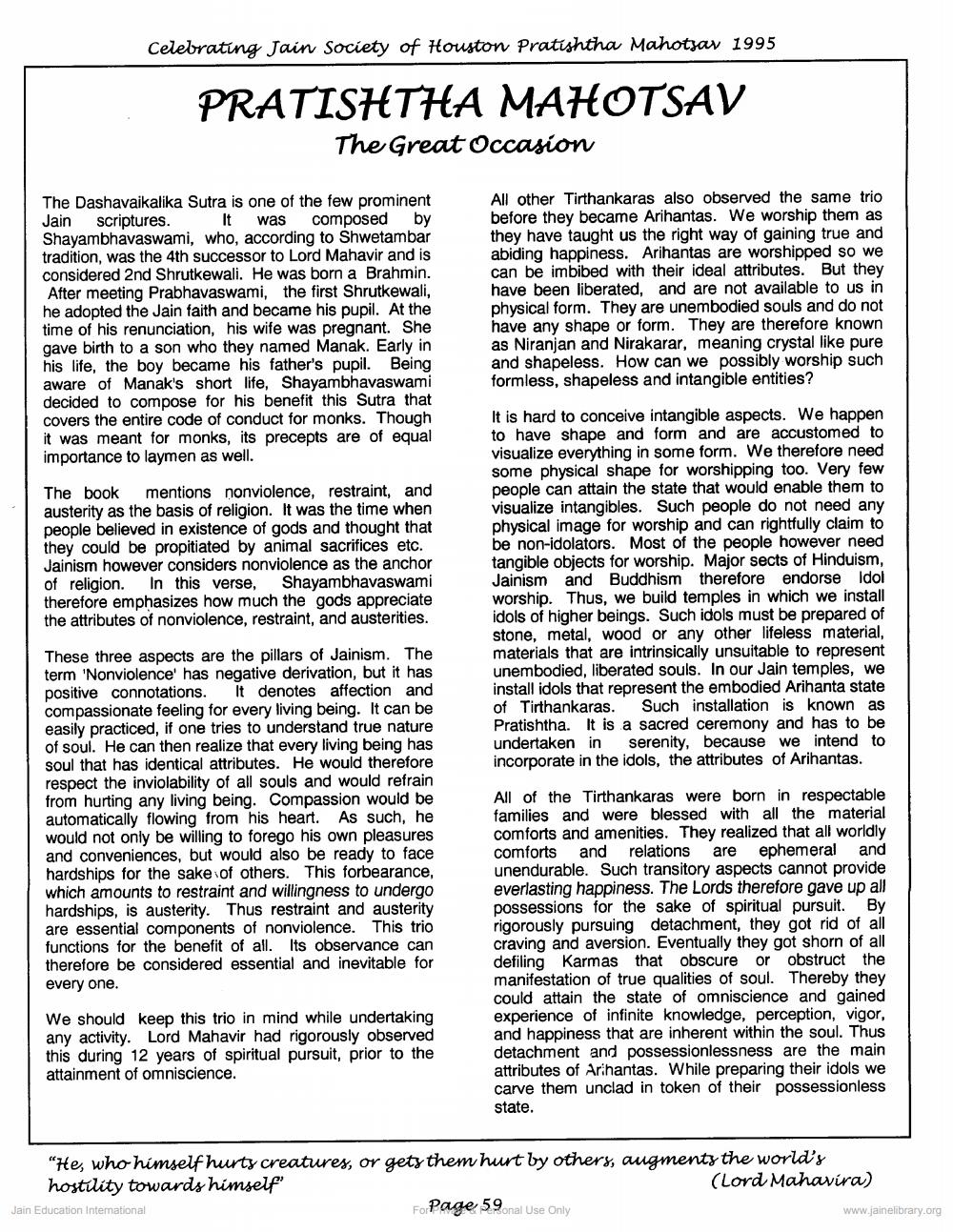________________
Celebrating Jain Society of Houston Pratishtha Mahotsav 1995
PRATISHTHA MAHOTSAV
The Great Occasion
The Dashavaikalika Sutra is one of the few prominent Jain Scriptures. It was composed by Shayambhavaswami, who, according to Shwetambar tradition, was the 4th successor to Lord Mahavir and is considered 2nd Shrutkewali. He was born a Brahmin.
After meeting Prabhavaswami, the first Shrutkewali, he adopted the Jain faith and became his pupil. At the time of his renunciation, his wife was pregnant. She gave birth to a son who they named Manak. Early in his life, the boy became his father's pupil. Being aware of Manak's short life, Shayambhavaswami decided to compose for his benefit this Sutra that covers the entire code of conduct for monks. Though it was meant for monks, its precepts are of equal importance to laymen as well.
All other Tirthankaras also observed the same trio before they became Arihantas. We worship them as they have taught us the right way of gaining true and abiding happiness. Arihantas are worshipped so we can be imbibed with their ideal attributes. But they have been liberated, and are not available to us in physical form. They are unembodied souls and do not have any shape or form. They are therefore known as Niranjan and Nirakarar, meaning crystal like pure and shapeless. How can we possibly worship such formless, shapeless and intangible entities?
The book mentions nonviolence, restraint, and austerity as the basis of religion. It was the time when people believed in existence of gods and thought that they could be propitiated by animal sacrifices etc. Jainism however considers nonviolence as the anchor of religion. In this verse, Shayambhavaswami therefore emphasizes how much the gods appreciate the attributes of nonviolence, restraint, and austerities.
It is hard to conceive intangible aspects. We happen to have shape and form and are accustomed to visualize everything in some form. We therefore need some physical shape for worshipping too. Very few people can attain the state that would enable them to visualize intangibles. Such people do not need any physical image for worship and can rightfully claim to be non-idolators. Most of the people however need tangible objects for worship. Major sects of Hinduism, Jainism and Buddhism therefore endorse Idol worship. Thus, we build temples in which we install idols of higher beings. Such idols must be prepared of stone, metal, wood or any other lifeless material, materials that are intrinsically unsuitable to represent unembodied, liberated souls. In our Jain temples, we install idols that represent the embodied Arihanta state of Tirthankaras. Such installation is known as Pratishtha. It is a sacred ceremony and has to be undertaken in serenity, because we intend to incorporate in the idols, the attributes of Arihantas.
These three aspects are the pillars of Jainism. The term 'Nonviolence' has negative derivation, but it has positive connotations. It denotes affection and compassionate feeling for every living being. It can be easily practiced, if one tries to understand true nature of soul. He can then realize that every living being has soul that has identical attributes. He would therefore respect the inviolability of all souls and would refrain from hurting any living being. Compassion would be automatically flowing from his heart. As such, he would not only be willing to forego his own pleasures and conveniences, but would also be ready to face hardships for the sake of others. This forbearance, which amounts to restraint and willingness to undergo hardships, is austerity. Thus restraint and austerity are essential components of nonviolence. This trio functions for the benefit of all. Its observance can therefore be considered essential and inevitable for every one.
All of the Tirthankaras were born in respectable families and were blessed with all the material comforts and amenities. They realized that all worldly comforts and relations are ephemeral and unendurable. Such transitory aspects cannot provide everlasting happiness. The Lords therefore gave up all possessions for the sake of spiritual pursuit. By rigorously pursuing detachment, they got rid of all craving and aversion. Eventually they got shorn of all defiling Karmas that obscure or obstruct the manifestation of true qualities of soul. Thereby they could attain the state of omniscience and gained experience of infinite knowledge, perception, vigor, and happiness that are inherent within the soul. Thus detachment and possessionlessness are the main attributes of Arihantas. While preparing their idols we carve them unclad in token of their possessionless state.
We should keep this trio in mind while undertaking any activity. Lord Mahavir had rigorously observed this during 12 years of spiritual pursuit, prior to the attainment of omniscience.
"He, who himself hurty creatures, or gety them hurt by others, augmenty the world's hostility towards himself
(Lord Mahavira) Jain Education International ForPage 59.nal Use Only
www.jainelibrary.org




